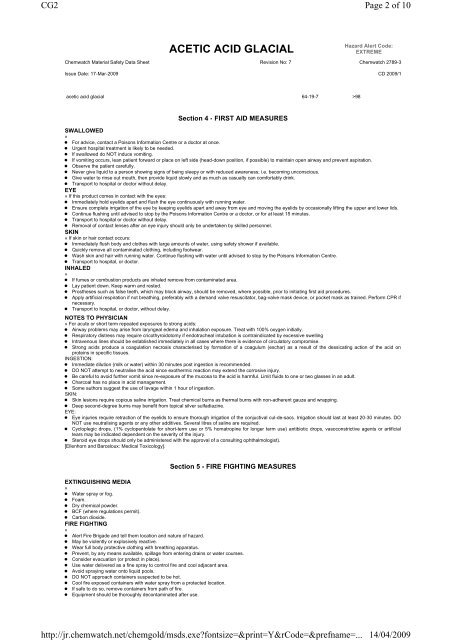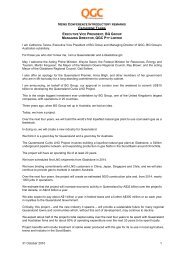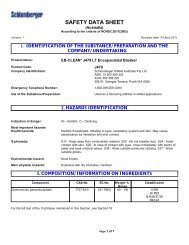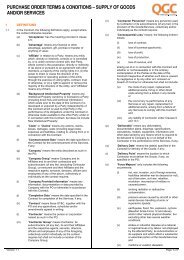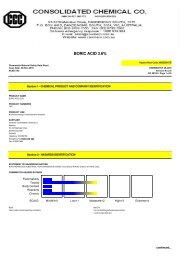Acetic Acid Glacial - QGC
Acetic Acid Glacial - QGC
Acetic Acid Glacial - QGC
- No tags were found...
You also want an ePaper? Increase the reach of your titles
YUMPU automatically turns print PDFs into web optimized ePapers that Google loves.
CG2http://jr.chemwatch.net/chemgold/msds.exe?fontsize=&print=Y&rCode=&prefname=...Page 2 of 1014/04/2009ACETIC ACID GLACIALHazard Alert Code:EXTREMEChemwatch Material Safety Data Sheet Revision No: 7 Chemwatch 2789-3Issue Date: 17-Mar-2009 CD 2009/1acetic acid glacial 64-19-7 >98Section 4 - FIRST AID MEASURESSWALLOWED» For advice, contact a Poisons Information Centre or a doctor at once. Urgent hospital treatment is likely to be needed. If swallowed do NOT induce vomiting. If vomiting occurs, lean patient forward or place on left side (head-down position, if possible) to maintain open airway and prevent aspiration. Observe the patient carefully. Never give liquid to a person showing signs of being sleepy or with reduced awareness; i.e. becoming unconscious. Give water to rinse out mouth, then provide liquid slowly and as much as casualty can comfortably drink. Transport to hospital or doctor without delay.EYE» If this product comes in contact with the eyes: Immediately hold eyelids apart and flush the eye continuously with running water. Ensure complete irrigation of the eye by keeping eyelids apart and away from eye and moving the eyelids by occasionally lifting the upper and lower lids. Continue flushing until advised to stop by the Poisons Information Centre or a doctor, or for at least 15 minutes. Transport to hospital or doctor without delay. Removal of contact lenses after an eye injury should only be undertaken by skilled personnel.SKIN» If skin or hair contact occurs: Immediately flush body and clothes with large amounts of water, using safety shower if available. Quickly remove all contaminated clothing, including footwear. Wash skin and hair with running water. Continue flushing with water until advised to stop by the Poisons Information Centre. Transport to hospital, or doctor.INHALED» If fumes or combustion products are inhaled remove from contaminated area. Lay patient down. Keep warm and rested. Prostheses such as false teeth, which may block airway, should be removed, where possible, prior to initiating first aid procedures. Apply artificial respiration if not breathing, preferably with a demand valve resuscitator, bag-valve mask device, or pocket mask as trained. Perform CPR ifnecessary. Transport to hospital, or doctor, without delay.NOTES TO PHYSICIAN» For acute or short term repeated exposures to strong acids: Airway problems may arise from laryngeal edema and inhalation exposure. Treat with 100% oxygen initially. Respiratory distress may require cricothyroidotomy if endotracheal intubation is contraindicated by excessive swelling Intravenous lines should be established immediately in all cases where there is evidence of circulatory compromise. Strong acids produce a coagulation necrosis characterised by formation of a coagulum (eschar) as a result of the dessicating action of the acid onproteins in specific tissues.INGESTION: Immediate dilution (milk or water) within 30 minutes post ingestion is recommended. DO NOT attempt to neutralise the acid since exothermic reaction may extend the corrosive injury. Be careful to avoid further vomit since re-exposure of the mucosa to the acid is harmful. Limit fluids to one or two glasses in an adult. Charcoal has no place in acid management. Some authors suggest the use of lavage within 1 hour of ingestion.SKIN: Skin lesions require copious saline irrigation. Treat chemical burns as thermal burns with non-adherent gauze and wrapping. Deep second-degree burns may benefit from topical silver sulfadiazine.EYE: Eye injuries require retraction of the eyelids to ensure thorough irrigation of the conjuctival cul-de-sacs. Irrigation should last at least 20-30 minutes. DONOT use neutralising agents or any other additives. Several litres of saline are required. Cycloplegic drops, (1% cyclopentolate for short-term use or 5% homatropine for longer term use) antibiotic drops, vasoconstrictive agents or artificialtears may be indicated dependent on the severity of the injury. Steroid eye drops should only be administered with the approval of a consulting ophthalmologist).[Ellenhorn and Barceloux: Medical Toxicology].Section 5 - FIRE FIGHTING MEASURESEXTINGUISHING MEDIA» Water spray or fog. Foam. Dry chemical powder. BCF (where regulations permit). Carbon dioxide.FIRE FIGHTING» Alert Fire Brigade and tell them location and nature of hazard. May be violently or explosively reactive. Wear full body protective clothing with breathing apparatus. Prevent, by any means available, spillage from entering drains or water courses. Consider evacuation (or protect in place). Use water delivered as a fine spray to control fire and cool adjacent area. Avoid spraying water onto liquid pools. DO NOT approach containers suspected to be hot. Cool fire exposed containers with water spray from a protected location. If safe to do so, remove containers from path of fire. Equipment should be thoroughly decontaminated after use.


